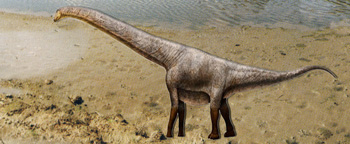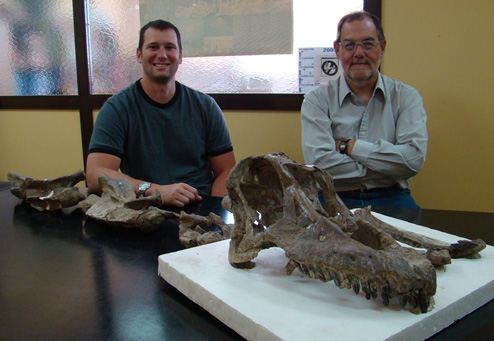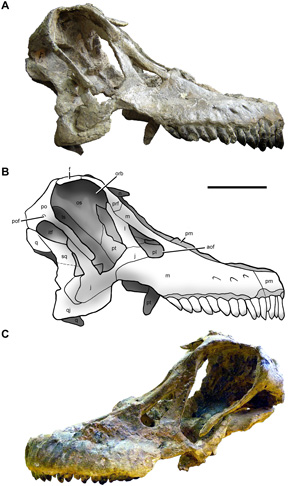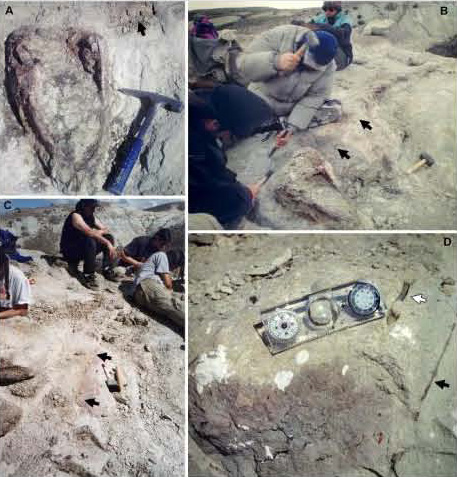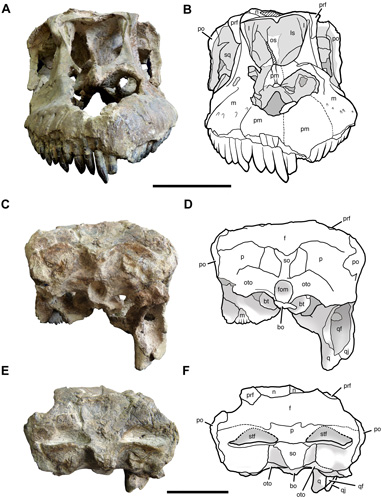A New Late Cretaceous Titanosaur from Patagonia
Sarmientosaurus musacchioi – A “Drop Head” Dinosaur
The beautifully preserved skull of a new type of titanosaur is helping scientists to understand the evolution of these herbivorous dinosaurs. Titanosaur skull fossils are exceptionally rare, but thanks to the skull of Sarmientosaurus musacchioi, palaeontologists have got a “heads up” on basal titanosaurs, ironically computer modelling and an analysis of the skull morphology suggests that this dinosaur may have specialised in feeding on low growing vegetation. If that was the case, then this long-necked dinosaur probably spent a lot of its time with its head pointing downwards towards the ground.
An Illustration of Sarmientosaurus musacchioi
Picture credit: Everything Dinosaur (background from the artwork of Julius Csotonyi
Rare Titanosaur Skull Fossil Discovery
Reporting in the on line academic journal PLOS One, the team of palaeontologists which includes lead author Dr Rubén D. F. Martínez (National University of Patagonia), describe a beautifully preserved and almost complete skull specimen excavated from strata which makes up the Lower Member of the Upper Cretaceous Bajo Barreal Formation in south, central Chubut Province, Patagonia (southern Argentina).
The fossils, comprising the skull plus elements from the neck are believed to date from around 95 million years ago (Middle Cenomanian stage of the Late Cretaceous).
Scientists Show Off the Beautifully Preserved Dinosaur Skull
Picture credit: Carnegie Museum of Natural History
The Titanosaur a Member of the Sauropodomorpha
The skulls of members of the Sauropodomorpha, the suborder of dinosaurs to which the titanosaurs belong, tend to be disproportionately small when compared to the size of the body. In addition, the skulls of these dinosaurs are at the end of a long neck. When an animal died and the carcase rotted away, then the skull bones were likely to become detached from the rest of the skeleton. Skull fossils of sauropods are exceptionally rare. In titanosauriforms, only three other skull fossils are known:
- Rapetosaurus (from the Late Cretaceous of Madagascar)
- Tapuiasaurus (from the Early Cretaceous of Brazil)
- Nemegtosaurus (from the Late Cretaceous of Mongolia
The discovery of an almost complete titanosaur skull will help scientists to understand more about the anatomy, evolution and behaviour of these dinosaurs. For example, analysis of the orbit within the skull and the relative position of the eye suggests that this dinosaur had particularly good vision. Such is the completeness of the fossil material that the scientists, which included Gondwana titanosaur specialist Dr Matthew Lamanna (Carnegie Museum of Natural History), have been able to piece together an endocast of the brain and demonstrate the shape of the inner ear.
Views of the Skull of Sarmientosaurus (Sarmientosaurus musacchioi)
Picture credit: PLOS One
The picture above shows the prepared skull seen in right lateral view (photograph A and line drawing B) and left lateral view (C). The naris slopes gently downwards towards the premaxilla and the orbit (eye-socket) is quite large. The simple, peg-like teeth (57 teeth associated with the fossil), project forward, an adaptation perhaps to assist with the combing action of feeding. The scale bar in the picture above represents ten centimetres.
For models and replicas of titanosaurs and other prehistoric animals: Prehistoric Animal Models and Figures.
Dr Lamanna noted:
“Titanosaurs included the biggest land animals ever, so we want to know as much about them as we can. But to truly understand a creature, you need to have its head and because titanosaur skulls are super-rare, lots of important aspects of how these dinosaurs lived and behaved have really been anybody’s guess.”
CAT Scans Reveal Previously Unseen Features in Titanosaur Fossil Material
The skull fossil has provided palaeontologists with their first really good view of a basal titanosaur and it has provided new information regarding the shape of the brain case and the senses of these dinosaurs. For example, CAT scans have enabled the researchers to model the structure of the inner ear, from this they have deduced that this dinosaur had good hearing, able to detect a wide range of low frequency airborne sounds. This perhaps provides a clue to how these herding animals communicated.
The Excavation of the Rare Titanosaur Fossil Material
Picture credit: PLOS One
The photographs above show the articulated skull lying upside down partially eroded out of the rock (A), note that the skull is seen in ventral view (viewed from underneath) and that the geological hammer provides an approximate scale.
The black arrow in photograph A shows the position of an ossified cervical tendon lying very close to the back of the skull. Photographs B and C show two views of the articulated skull and the partial cervical series (neck bones) exposed in the rock (ventral view). The black arrows indicate the position of cervical tendons. Photograph D shows a cervical rib (white arrow) and its relationship in the matrix to an ossified cervical tendon (black arrow), the field instruments provide an approximate scale.
Ossified Bony Tendons
When compared to the Tapuiasaurus fossil skull from Brazil which dates from around 115 million years ago, the teeth and skull morphology of Sarmientosaurus are relatively primitive. The researchers have concluded that radically different titanosauriforms probably co-existed for much of the Cretaceous. This suggests that different types of titanosaur evolved to fill different ecological niches and perhaps this might help to explain why these types of plant-eaters made up a substantial portion of the herbivorous mega fauna fossils associated with the Southern Hemisphere in the Late Cretaceous.
Views of the Restored Skull of Sarmientosaurus
Picture credit: PLOS One
In the picture above, A, C and E are photographs of the skull in various views. A frontal view (A), a view of the back (B) and a caudodorsal view (C) which is a view of the back of the skull from the orientation of looking down on it from the top. The images B, D and F are diagrams that show the individual bones and skull features as preserved in the fossil material. Sarmientosaurus is the first non-avian dinosaur to show evidence of a very long bony tendon in the neck. The research team compare the thin ossified tendon with that found in extant Cranes. The function of this structure is not known.
Superior Senses When Compared to Other Sauropodomorphs
The CAT scans provided a remarkable amount of detailed information regarding the sensory capabilities of this titanosaur. The large eye-socket indicated good eyesight and the orientation of the balance organ of the inner ear suggests that this dinosaur probably held its head with the snout facing downward. From this it has been inferred that Sarmientosaurus fed mainly on low-growing plants.
Professor Lawrence Witmer, a specialist in cranial anatomy and one of the co-authors of the scientific paper explained:
“The Sarmientosaurus skull is beautifully-preserved, which meant that we could tease out a ton of information. It was really exciting for us to work through the CT scan data because it gave us a glimpse into the biology and lifestyle of this animal like we rarely get with dinosaurs.”
What’s in a Name?
The genus name honours the small town of Sarmiento in Chubut Province which is close to the fossil quarry where the skull was found. The trivial name is in tribute to the late Dr Eduardo Musacchio, a palaeontologist and professor at the National University of Patagonia who was a mentor to Dr Martínez as well as a close friend.
Visit Everything Dinosaur’s award-winning website: Everything Dinosaur.


